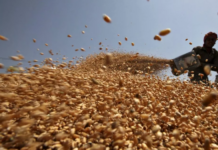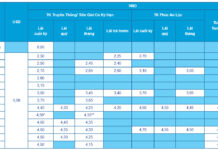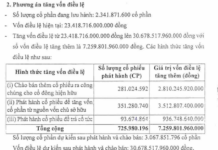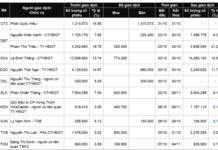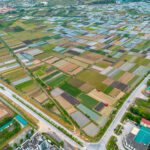
From late afternoon of 28 April, the 30km initial section of Dien Chau – Bai Vot expressway will officially open to traffic, meeting the transportation demand of travelers during the upcoming holiday of April 30 – May 1st – Photo : Giao thong Newspaper
Prime Minister Pham Minh Chinh has directly inspected the construction sites and led the implementation of multiple solutions to ensure progress while urging relevant units to complete Dien Chau – Bai Vot and Cam Lam – Vinh Hao projects in time for April 30, the date that marks the Liberation of Southern Vietnam and the Reunification of the country.
Shortening the Hanoi – Vinh route
The Dien Chau – Bai Vot expressway, over 49km long and passing through Nghe An and Ha Tinh provinces, will open its first 30km, from the starting point to the junction with National Highway 46B, on April 30. The remaining 19km section, having weak ground that requires waiting time for surcharge, will be completed later.
Dien Chau – Bai Vot expressway was started in May 2021 with a total investment of over 11,150 billion VND, of which 44.4km are in Nghe An province and 4.9km in Ha Tinh province.
Thus, once this route is completed, the travel time from Hanoi to Vinh City (Nghe An) will be reduced to 3.5 hours instead of 5 hours if traveling on National Highway 1.
Mr. Nguyen Quang Tieu, Vice Chairman of Cu Lo Town People’s Committee, Nghe An Province, stated: “This year will be a great victory for Cu Lo coastal tourism”. That is because the transportation infrastructure system in Nghe An in general and Cu Lo in particular has been invested in, built, and upgraded in a systematic and comprehensive manner.

The expressway section passing through Than Vu Tunnel area has a very wild and magnificent natural landscape – Photo: Giao thong Newspaper
Regarding the project completion process, at a recent meeting on April 23, the Minister of Transport, Nguyen Van Thang, shared: “About 10 days ago, the tasks were still quite complicated, and we did not dare to think about opening to traffic on April 30. However, contractors within the consortium actively supported each other. Notably, contractors from other projects even brought their machines, workers, and engineers to provide consulting on solutions in order to accelerate the progress of important items. This is the spirit of community and responsibility’ for the common interests of the country, which has helped two expressway routes be inaugurated on the occasion of April 30”.
Mr. Truong Duc Lien, Deputy Director of Phuc Thanh Hung Joint Stock Company (the project implementer), informed that the project commenced in May 2021. However, it was not until February 12, 2022 that the loan contract was signed with a loan capital of 3,560 billion VND. Project construction coincided with the period when the prices of construction materials were skyrocketing, and many sections had weak ground and complex geology, which further increased the difficulties for investors and contractors.
Nevertheless, thanks to the attention of the Government, the Prime Minister, the leaders of the Ministry of Transport, and the efforts of investors and contractors, the project has been completed on schedule.
Mr. Phung The Vinh, Deputy Director of the Department of Construction Management and Quality of Transport Works, Ministry of Transport, stated: “The project has up to 5 investors, and in the early stages, the connection between the 5 investors faced some difficulties. However, shortly after that, the investors joined hands and made efforts to bring the project to completion on schedule”.

Cam Lam – Vinh Hao expressway has been completed and is awaiting the opening order. Photo: Vinh Phu
From Ho Chi Minh City to Nha Trang in just a 5-hour drive
Cam Lam – Vinh Hao expressway has a total investment of nearly 9,000 billion VND and was completed one month ahead of schedule. After opening to traffic, the distance from Ho Chi Minh City to the tourist city of Nha Trang (Khanh Hoa) will be shortened to nearly 5 hours by car, instead of 8 hours if traveling on National Highway 1.
The project is 78.5km long, passing through 3 provinces: Khanh Hoa (nearly 5km), Ninh Thuan (63km), and Binh Thuan (nearly 12km), and is invested in by the joint venture of Deo Ca Group – Company 194.
Cam Lam – Vinh Hao expressway is one of the three component projects of the North – South Expressway, phase 1, invested in under the public-private partnership (PPP) model.
Mr. Nguyen Van Long, Deputy Director of PMU 85, said that the Cam Lam – Vinh Hao expressway has been thoroughly checked for traffic safety (ATGT) and is ready for opening to traffic.
“The temporary rest stop items, including parking lots, rest areas, electricity, lighting at the junction of the expressway with Provincial Road 709, have also been basically completed. The construction unit has completed the installation of information road signs leading to the temporary rest stop, ensuring they are ready to serve road users when they need to stop and rest on the expressway”, Mr. Long informed.
Representatives from Deo Ca Group said that the expressway operation and management team is ready to ensure traffic safety on the expressway. Soft drinks will be served at the rest stop area for drivers and road users. The rest stop has restrooms (with air-conditioning), provides 4G wifi, has two vending machines, and provides free mineral water.
Talking about the project construction process, Mr. Nguyen Van Ngoi, Deputy General Director of Company 194 (a member of the Deo Ca – Company 194 Joint Venture), said that the COVID-19 pandemic was still severe when the project commenced. Mobilizing equipment and personnel faced many obstacles due to the prolonged pandemic and travel restrictions imposed by many localities.
Once the pandemic was over, the investor concentrated resources on construction and identified the bottlenecks of the project. There were two very large bridges on the route in Khanh Hoa province, which had steep and rugged terrain, making the transportation of materials, food, and provisions very difficult. The geological difficulties and the shortage of materials at that time required contractors to have reasonable construction plans.




